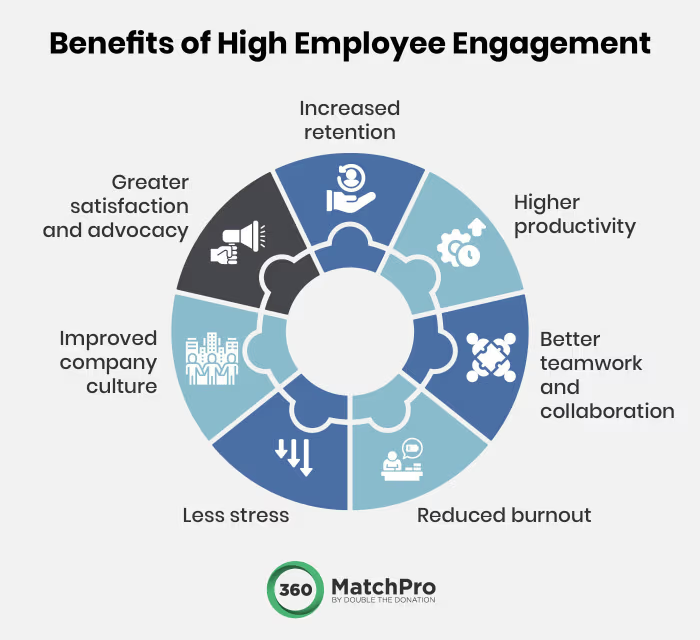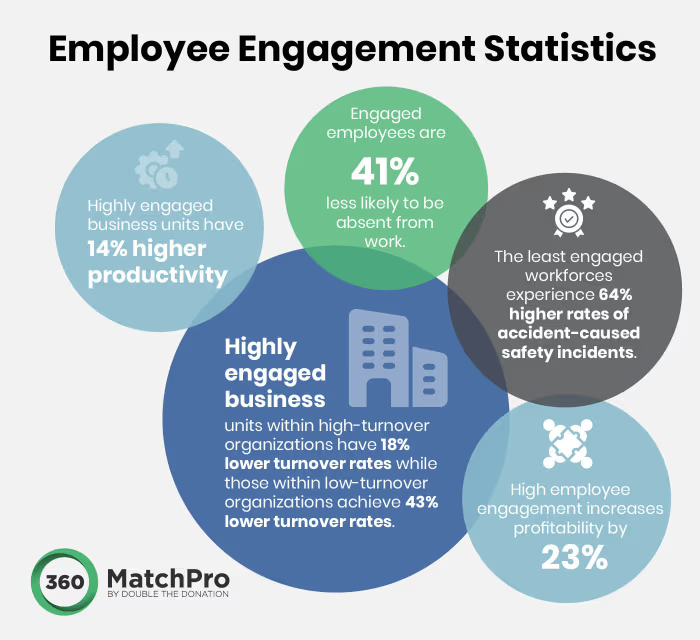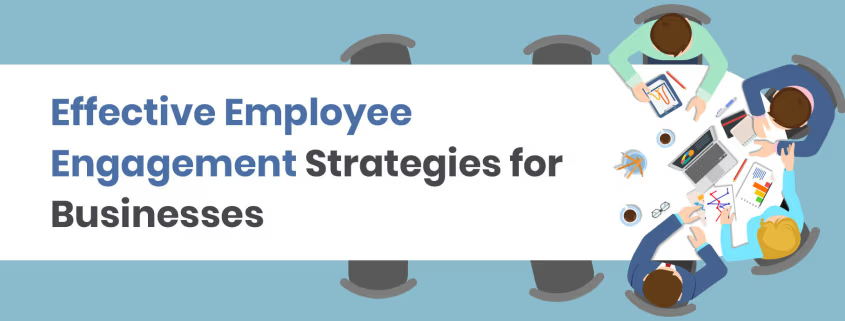11 Effective Employee Engagement Strategies for Businesses
In 2022, only 32% of employees reported feeling engaged in their work. If over two-thirds of all employees don’t feel motivated to do their best, how can companies be expected to perform at their highest capacity?
To keep employees interested in and productive at work, companies need to actively prioritize employee engagement. In this guide, we’ll review the basics of employee engagement and several effective employee engagement strategies:
- What Is Employee Engagement?
- What Are the Benefits of High Employee Engagement?
- 11 Employee Engagement Strategies Your Company Can Implement
- Employee Engagement in Action
Whether you’re trying to transform disengaged employees into highly motivated ones or taking preventative measures to reduce employee turnover, this guide will help you develop a successful employee engagement approach.
What Is Employee Engagement?
Employee engagement is a reflection of one’s connection and commitment to the workplace. When employees are engaged, they want to put their best foot forward so that not only do they succeed, but the business does as well.
Employee engagement isn’t a “strategy” in and of itself. However, implementing strategies to increase employee engagement will make it more likely that your workforce feels empowered to come to work each day and do their best.
What Are the Benefits of High Employee Engagement?
You may be wondering whether it’s worth investing in employee engagement strategies. To prove the importance of employee engagement, we’ve compiled a list of benefits of high employee engagement for your employees and your business:
- Increased retention. It makes sense that employees who are engaged and invested in their work are less likely to leave their current employer. According to Gallup, highly engaged business units within high-turnover organizations have 18% lower turnover rates while those within low-turnover organizations achieve 43% lower turnover rates.
- Higher productivity. Gallup’s employee engagement study also reports that highly engaged business units have 14% higher productivity. Engaged employees stay on track and complete their work efficiently in order to make a positive impact on the business.
- Better teamwork and collaboration. When employees are committed to their team, they’re more likely to ask questions and collaborate with others, leading to even better business outcomes. The power of multiple perspectives and ideas coming together can spark innovation that propels the business above its competitors.
- Reduced burnout. When employers take active measures to ensure their employees’ well-being and engagement, they help their employees develop healthier working habits and prevent burnout. As a result, engaged employees are 41% less likely to be absent from work.
- Less stress. Employees who don’t feel a connection to their workplace may see their work as purely stressful instead of challenging and empowering. These high stress levels can cloud employees’ judgment and jeopardize their safety in the workplace, with the least engaged workforces experiencing 64% higher rates of accident-caused safety incidents.
- Improved company culture. Engaged employees are more likely to help each other out and bring a positive outlook to work. As a result, they make the workplace a better, more welcoming environment for everyone.
- Greater satisfaction and advocacy. Job applicants want to know that current employees are satisfied with their jobs and would recommend their employer to others. Companies that implement employee engagement strategies are more likely to see their employees advocate for them on social media, creating a positive image for the company.

Overall, high employee engagement has better personal and business outcomes for your entire workforce, resulting in a potential 23% increase in profitability.
11 Employee Engagement Strategies Your Company Can Implement
Equipped with information about the importance of employee engagement, your company can now experiment with different strategies to keep your team highly motivated.
1. Collect Employee Feedback
Employees want to know that their voices are being heard. When you collect employee feedback, you allow your workforce to share their thoughts, opinions, and suggestions on business processes.
For example, your company could send out a quarterly survey asking employees if they have ideas for making your team more efficient. Then, you can review these responses and respond directly to employees about how their suggestions will be implemented.
To facilitate the employee feedback process, use an employee engagement platform that offers surveys. This type of software will allow you to organize responses and store them for future reference.
2. Promote Open Communication
According to Harvard Business Review, 69% of managers are uncomfortable communicating with their employees. On the other hand, many employees don’t feel like they’re receiving clear directions from their managers. Since the manager-employee relationship is vital to employees’ progress and success, it’s important to break down barriers to effective communication.
Implement procedures that provide structure to manager-employee check-ins and make it easy for both parties to participate. Have the employee open the conversation with any questions or concerns they have about their work. After the manager addresses the employee’s concerns, they should provide feedback on the employee’s performance.
Train managers on how to give constructive feedback with positive framing and actionable next steps. For example, a manager may give a compliment and critical feedback in the same meeting to avoid overwhelming the employee with negativity.
There should also be open communication between company leadership and employees. Considering that 85% of employees report being more motivated when they receive regular company updates, be sure to keep employees in the loop about higher-level initiatives.
3. Provide Professional Development Opportunities
LinkedIn’s 2023 Workplace Learning Report reveals that employees’ top priority for workplace learning is to progress toward their career goals. Luckily, there is a variety of ways companies can help employees live up to their potential and develop their skills:
- Training opportunities. Learning on the job shouldn’t stop with onboarding. Providing regular training opportunities allows employees to continuously grow in their roles and industry knowledge. Compile resources such as local industry workshops or relevant online courses your employees can leverage.
- Internal mobility. After two years of working for a company, employees who have been promoted have a 19% higher likelihood of staying at the business. Employees want to be challenged and take on leadership roles that help them build new skills. As a result, they’ll be more engaged in the workplace and committed to your organization.
- Mentorship. Whether employees are new to the business or just want to sharpen their skills, coaching can help them learn new things and deepen their workplace relationships. Set up a mentorship program where mentors and mentees can opt-in to participate. You can even designate mentors in specific areas such as workplace communication or effective goal setting so mentees can learn about what most interests them.
- Further education. Support employees looking to receive further education related to their roles by offering financial assistance or time off. Seek out opportunities to partner with organizations that offer employee learning programs at free or discounted rates.
When you create a culture of constant learning, you also encourage employees to ask questions and seek help, further improving internal communication, productivity, and performance.
4. Create a Corporate Giving Program
About 71% of employees want to work for a company that contributes to the greater good. When you create a corporate giving program, you not only help nonprofits pursue their missions, but you also keep employees engaged.
If your company is new to corporate giving, start with the following initiatives that give employees a chance to maximize support for their favorite causes:
Matching Gifts
The most popular form of corporate giving is matching gifts. When an employee submits a donation to a nonprofit, companies will match that donation at a predetermined ratio. While 91% of companies match donations at a 1:1 ratio, some match at a 2:1 or 3:1 ratio! As a result, nonprofits increase their donation revenue, while employees feel a sense of pride in supporting their favorite causes with your help.
To facilitate the matching gift process, implement a dedicated corporate giving solution. This type of platform will organize all incoming donation match requests so you can easily manage them. Nonprofits also leverage corporate giving software so employees can request matching gifts straight from their donation pages.
Typically, employees search for their employer through the platform and manually fill out a donation request. If your corporate giving software integrates with the nonprofit’s, then that request will go straight to your platform where you can act on it.
There are also some software providers that make this process even easier through auto-submission. Platforms like 360MatchPro allow donors to simply enter their corporate email address and have the donation match request sent on their behalf. When you invest in a CLMA-certified CSR vendor (or a Certified Leader in Matching Automation), you can activate auto-submission functionality for your employees, making it easier than ever for them to get involved.
Check out this video to learn more about how auto-submission works with 360MatchPro:
While 360MatchPro is a form of nonprofit matching gift software, your company can leverage a platform that integrates with 360MatchPro, allowing employees to participate in your corporate giving program more easily.
Volunteer Grants
Volunteering is a great way to bring employees together and have them work toward a common goal. While the experience of volunteering with your team itself can increase employee engagement, you can encourage further participation in your corporate giving efforts with volunteer grants.
Volunteer grants work similarly to matching gifts. When an employee volunteers with a nonprofit, they can record the number of hours they’ve spent assisting that organization. Then, they can submit their hours to their employer, who will donate a certain amount to the nonprofit per volunteer hour.
This corporate giving initiative helps nonprofits gain more donations and volunteers. Additionally, volunteer grants allow employees to make a larger impact with the help of their employers. Employees will feel more connected to the workplace after partnering with their company to make the world a better place.
5. Recognize Employees for Their Achievements
A little recognition for your employees’ hard work can go a long way. People feel more motivated to continue doing their best in the workplace when they know their employer appreciates their efforts.
While you may already have some employee recognition practices in place, it’s important to revisit your approach to employee recognition periodically to ensure your employees feel appreciated. Check out these ideas to keep your recognition efforts fresh and exciting:
- eCards. You’ve likely only seen eCards sent for personal use, but did you know they can be an effective employee recognition tactic? Sending employees a quick eCard to celebrate their accomplishments, highlight positive client feedback, and recognize work anniversaries can brighten their day. With eCard software, you can brand your eCards to your company and create templates for different purposes. You can even encourage peer-to-peer recognition by having employees send eCards to each other when they notice something a coworker does well.
- Gifts. A gift is a tangible reminder of your appreciation. Consider stockpiling gift cards so you can easily hand them out to employees when they excel on a project or receive positive client feedback. For larger accomplishments, give more personalized gifts, such as branded merchandise or gift baskets.
- Events. Bring all your employees together to celebrate their accomplishments. For example, you can host a dinner or office party at the end of the year to recognize your employees’ hard work. You may also choose to organize a celebration for employee-related holidays such as National Employee Appreciation Day.
- Awards. Publicly recognize your employees with recognition awards when they conquer a large task or complete a goal. For instance, you may give an employee an award when they make a new sale. These awards can be as formal as a plaque or trophy or as informal as a free meal or coffee on the company.
Whichever employee recognition methods you choose, you can streamline those efforts using employee recognition software. That way, you can keep track of employee recognition and systematically implement your practices.
6. Encourage Healthy Work-Life Balance
When employees feel burnt out, they can’t put their best foot forward in the workplace. It’s up to your company to encourage a healthy work-life balance so employees know it’s okay to take breaks from work. Especially in a remote work environment, maintaining this balance is vital.
While you may offer considerable time off, new employees may feel pressured to limit the number of days they take off from work. Let them know that it’s not only acceptable to step away from work from time to time, but it’s encouraged to ensure employees stay focused and engaged in the workplace.
It’s also important to set realistic expectations for what employees can accomplish within regular working hours. Do your best to distribute work as evenly as possible so no individual team members are responsible for an abundance of work that causes them to work overtime.
7. Develop an Inclusive Workplace Environment
According to Pew Research, 57% of employees have left jobs due to feeling disrespected at work. Make employees feel comfortable in the workplace so they can focus on their work without worrying about their well-being.
Create a no-tolerance policy for workplace discrimination of any kind. Ensure every employee is informed of the policy and the repercussions of violating it. Companies should also take active measures in the recruitment and hiring processes to build a diverse workforce of people who can offer different perspectives in the workplace.
To get employees more involved in building a positive, inclusive workplace culture, establish employee resource groups. These employee-led groups help people celebrate different identities in the workplace and match underrepresented groups with the support they need to succeed.
8. Stay True to Your Core Values
Most companies list their core values on their websites and internal company handbooks. However, if your company doesn’t actively uphold these values, they have little meaning for employees.
When you regularly promote your company’s core values, you help employees develop a sense of purpose and belonging in the workplace. Emphasize these values in training so team members know what they’re striving for from the start.
To make these values more tangible, regularly recognize employees who exemplify one of these ideals. Consider sending a monthly email highlighting real examples of employees upholding each value and how their efforts improve the workplace environment.
9. Adopt a Holistic Compensation Policy
Compensation doesn’t just mean a regular paycheck. Diversifying the ways you compensate your employees shows you prioritize a positive employee experience.
In addition to salary and bonuses, you can offer indirect compensation such as generous paid time off, retirement plans, health insurance, training, and health and wellness programs. Employees will be more engaged when they know you have a stake in their well-being and career progression.
10. Let Team Members Get to Know Each Other
When employees know each other better, they work better together. This team cohesion leads to a better workplace environment and a more engaged workforce.
Plan events such as company dinners or outings that promote team bonding outside the workplace. Removed from the work day, employees can foster personal connections and gain a better understanding of their coworkers.
For a team bonding experience that also helps worthy nonprofits, provide corporate volunteering opportunities. Seek out charitable organizations looking for volunteer groups. Then, have your employees sign up and work together for a worthy cause. Volunteering builds teamwork and helps employees feel more connected to your company.
11. Provide Flexibility
One of the greatest ways you can reward employees and ensure their continued engagement is with flexibility. Hybrid work models combine the benefits of in-person team interactions with the comfort of working from home.
You can also provide flexibility during the work week. Instead of requiring employees to be in the office from 9 am to 5 pm, allow them to choose their own working hours. This practice can be especially helpful for working parents or people pursuing an education.
Additionally, allow employees to reallocate a certain number of hours during the week for situations like travel or doctor’s appointments so they can reserve their time off for rest and relaxation.
Employee Engagement in Action
We’ve explored top strategies, but what do these engagement programs look like in practice? Exploring real-world case studies can help your business identify what works well at different types of organizations, what factors they had to control for, if there were any unintended side effects, and if the programs had the desired results.
Here are five companies that rolled out and found success with different types of employee engagement programs. For small businesses, you can use these examples as starting points and scale them down to fit your needs.
- Google. Businesses can offer more than one employee engagement program like Google, which offers matching grants, nonprofit grant programs, and employee well-being initiatives. By providing multiple employee engagement programs, everyone at your company can find some activity to connect with.
- Patagonia. Patagonia is committed to cleaning up after itself with CSR practices focused on making its supply chain as eco-friendly as possible. The fashion industry has a poor reputation when it comes to sustainability, but Patagonia employees can rest assured that their employer is doing its part to reduce waste.
- Adobe. Wellness is essential for preventing burnout, and Adobe accounts for both employees’ physical and mental health. Employees can buy gym memberships, air purifiers, art class entry, or any other purchases that support their well-being and have the costs reimbursed by Adobe.
- Checkr. Employee giving programs give team members an active role in improving their community, and companies like Checkr that enable matching gift auto-submission make participation as easy as possible. To give back, all employees need to do is confirm they’re a Checkr employee when donating, and their matching gift request is processed automatically for them.
- Ben & Jerry’s. Many corporations have foundations that supply worthy causes for grants, but some companies like Ben & Jerry’s take a different approach by funding advocacy groups. Employees who believe in equity, social justice, and other causes Ben & Jerry’s supports can feel confident their employer is fighting to create legislation they support.
When researching employee engagement case studies, consider each company’s unique situation. For example, a business with a more competitive company culture than yours might find greater success in a bonus pay structure but have its time off policy fall short of expectations.
Ultimately, talk with your employees to learn how they want to be engaged and look for programs that would meet their needs.
Wrapping Up & Additional Resources
Your company can actively promote employee commitment and productivity through dedicated employee engagement strategies. With an approach that’s individualized to your team’s preferences and needs, you can provide a better working environment and help your team perform at their highest capacity.
If you’re looking to learn more about some of the employee engagement strategies we’ve reviewed, check out these additional resources:
- How to Start a Matching Gift Program [For Companies]. Corporate giving is one of the top strategies for encouraging employee engagement. Learn how you can create your own matching gift program to kickstart your corporate giving efforts.
- 22 Employee Recognition Platforms To Recharge Your Workplace. There are so many tools out there to help you increase employee engagement through proper recognition. Take advantage of different employee recognition platforms with the help of this article.
- Why Is Employee Engagement Important? A Company’s FAQ Guide. Motivated employees can make a profound impact on your company. Discover the benefits of engaged employees, from productivity to better quality work overall.




